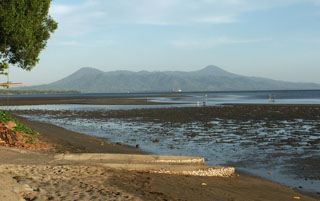Report on Krummel-Garbuna-Welcker (Papua New Guinea) — May 2007
Bulletin of the Global Volcanism Network, vol. 32, no. 5 (May 2007)
Managing Editor: Edward Venzke.
Krummel-Garbuna-Welcker (Papua New Guinea) Boiling water in two summit craters, low seismicity
Please cite this report as:
Global Volcanism Program, 2007. Report on Krummel-Garbuna-Welcker (Papua New Guinea) (Venzke, E., ed.). Bulletin of the Global Volcanism Network, 32:5. Smithsonian Institution. https://doi.org/10.5479/si.GVP.BGVN200705-252070
Krummel-Garbuna-Welcker
Papua New Guinea
5.416°S, 150.027°E; summit elev. 564 m
All times are local (unless otherwise noted)
According to the Rabaul Volcanological Observatory (RVO), Garbuna remained quiet from February 2006 through 10 June 2007. Two vents produced the first historically witnessed eruption from this volcano in October 2005 (BGVN 30:11). At least one summit vent continued to release small-to-moderate volumes of white vapor that could be seen from the observation post 15 km SE. There have been no noises heard nor glow observed at night.
An aerial inspection on 2 February 2006 revealed that both summit vents had increased in size and contained vigorously boiling water. The town of Kimbe (-16.6 km SE) experienced continuous rainfall during the days prior to this inspection. A weak smell of sulfur was detected 5 km E of Garbuna on 2 February. Seismic activity was at a low level, between 0 and 9 earthquakes per day, dominated by high-frequency events. Some low-frequency events were also recorded. A faulty seismometer at the summit was replaced and a new global positioning system (GPS) station for monitoring ground deformation was installed on 2 February 2006.
During December 2006 through 10 June 2007, seismicity continued at a low level, dominated by high-frequency volcanic earthquakes (87 in number) recorded daily; none were located due to insufficient seismic stations. Daily totals in December 2006 ranged between 1 and 16 earthquakes, the highest number of events (16) being recorded on 22 December 2006. No low-frequency earthquakes were recorded during December 2006. During January through 10 June 2007 there were 2-3 daily high-frequency events on average, with up to 5 on some days. The summit seismograph picked up continual tremor from the boiling lake in the main vent. Technical problems with the summit seismometer were experienced at times in March, May, and June. Based on GPS measurements, ground deformation showed no significant changes during this period.
Geological Summary. The basaltic-to-dacitic Krummel-Garbuna-Welcker Volcanic Complex consists of three volcanic peaks located along a 7-km N-S line above a shield-like foundation at the southern end of the Willaumez Peninsula. The central and lower peaks of the centrally located Garbuna contain a large vegetation-free area that is probably the most extensive thermal field in Papua New Guinea. A prominent lava dome and blocky lava flow in the center of thermal area have resisted destruction by thermal activity, and may be of Holocene age. Krummel volcano at the south end of the group contains a summit crater, breached to the NW. The highest peak of the group is Welcker volcano, which has fed blocky lava flows that extend to the eastern coast of the peninsula. The last major eruption from both it and Garbuna volcanoes took place about 1800 years ago. The first historical eruption took place at Garbuna in October 2005.
Information Contacts: Herman Patia, Steve Saunders, and Felix Taranu, Rabaul Volcano Observatory (RVO), PO Box 3386, Rabaul, E.N.B.P, Papua New Guinea.

